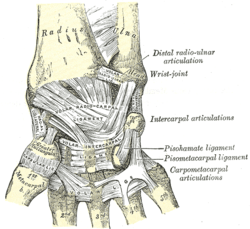Condyloid joint
| Condyloid joint | |
|---|---|
 1: Ball and socket joint; 2: Condyloid joint (Ellipsoid); 3: Saddle joint; 4 Hinge joint; 5: Pivot joint; | |
 Ligaments of wrist. Palmaris view | |
| Details | |
| Identifiers | |
| Latin | articulatio ellipsoidea |
| TA | A03.0.00.049 |
| FMA | 75299 |
| Anatomical terminology | |
A condyloid joint (also called condylar, ellipsoidal, or bicondylar[1]) is an ovoid articular surface, or condyle that is received into an elliptical cavity. This permits movement in two planes, allowing flexion, extension, adduction, abduction, and circumduction.
Examples
Examples include:[2]
These are also called ellipsoid joints. The oval-shaped condyle of one bone fits into the elliptical cavity of the other bone. These joints allow biaxial movements -- i.e., forward and backward, or from side to side, but not rotation. Radiocarpal joint and Metacarpo-phalangeal joint are examples of condyloid joint.
An example of an Ellipsoid joint is the wrist; it functions similarly to the ball and socket joint except is unable to move 360 degrees; it permits axial rotation.
References
This article incorporates text in the public domain from page 285 of the 20th edition of Gray's Anatomy (1918)
- ↑ Rogers, Kara (2010) Bone and Muscle: Structure, Force, and Motion p.163
- ↑ Module - Introduction to Joints Archived January 16, 2009, at the Wayback Machine.
| Wikimedia Commons has media related to Condyloid joints. |